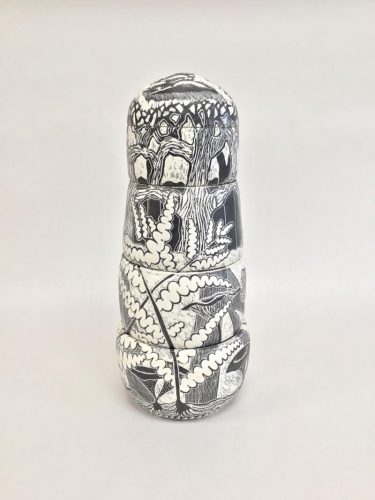
These exhibitions are shown from March 7 – 30 with an opening reception on March 7 from 5-7. Tim Christensen will give a talk on March 9 at 1 and Henry Isaacs on March 16 at 1.
Greenhut is pleased to announce its first exhibition of work by printmaker, PMA Biennial featured porcelain artist, environmentalist, and writer, Tim Christensen. The exhibition is titled, “In Response to Chaos” and the work featured in this show is the culmination of his latest sea voyage.
When I googled “Container Ship Passage Australia” 2-1/2 years ago, it was with the intention that I would create a body of work that would chronicle an odyssey. I had been asked to present my pecha kucha talk, “Art in the Holocene Extinction” in Cooroy, Queensland, and from this invitation, I created a “mega-transect,” a study of the Earth’s systems that would come to span the major oceans, 6 of the 7 continents, and take me around the world using about 5 gallons of crude oil. I would experience the heat of the Sudanese Red Sea, the wet of the Bornean Jungle, the loneliness of the Pacific, the space of the Australian bush, and the chaos of living in places where everything is unfamiliar and new. I would experience hurricanes, typhoons, pirates, state security services, dingos, snakes, insects, flying fish, whales, sharks, sea snakes, macaques, leeches, superstition, inescapable reality, and plastic. I would see rare birds, rare sea creatures, rare atmospheric events, rare primates, and catch rare glimpses into lives- foreign and internal. In setting out to experience the world’s most remote places, I committed to recording my experiences in as many durable, tangible, and recognizable ways I could think of.
I had two rules for this project: “Make everything possible as new as possible,” and “Always say, ’Yes.’” The resulting work reflects my observations of subjects internal and external. I looked at everything as equally valid and important, from traditional math- based-scientific data to more abstractly emotional and philosophical ideas.
I have used infinitely durable porcelain and universal visual language (Art!), to communicate what I saw across time, language, culture, and geographic barriers. These artifacts are designed to last tens of thousands of years and be accessible to anyone or anything with an eyeball and the ability to think abstractly. I conveyed the intimate daily experiences of the first voyage in that most personal of ways: by writing a book. Reflect, Adapt, and Persevere, co-written by Carri Lange and bound by Anna Low, was made using archival paper and inks, a self-created font of my handwriting, original drawings and intaglio prints, and a combination of ancient and modern silk screen printing processes and materials. During my travels, I used durable and portable etching plates and ancient drypoint to record my environment, often en plein air, capturing each day’s most compelling event, and later learned intaglio printing to create multiple images of what I saw. In all cases, I have “shown my work”, allowing the growth in the way I express myself to be evident alongside that which I was expressing.
Tim Christensen lives in Maine, splitting his time between Franklin and Roque Bluffs.

In the side gallery this month, Greenhut presents another travel-themed exhibition: Travel Notes, small paintings by Henry Isaacs. Writer and art critic, Dan Kany, has authored a booklet to accompany the show. An excerpt from Henry’s introduction to the Travel Notes booklet:
Sicily, Spring 2014. I am sitting in a cafe in front of Il Duomo di Cefalù on a Sunday morning. It is a quiet, sunny place. The vast space is empty. My palettes and brushes are set. My first sketch is exciting, and so I set to work. It was a Sunday, and after mass the children were the first out, and some ran over to me, curious to see what I was doing. Soon enough, there was a bunch of people around me. The waiter was happy because there was much more business. I worked very slowly because I was really comfortable, and I had plenty of time since Donna was off shopping. I heard one man say to the kids, ‘He seems nice. Go. Ask him about the colors. Why is he using those colors?’ ‘Lui sembra simpati-co. Vai.’ They did. I teased the children: ‘Do you have a problem with my colors?’ ‘No, sir! Grandfather. Where do you get those colors?’ ‘These are the best colors in the world,’ I replied in my broken Italian, ’Where do you think I get them?’ After a bit of back and forth about the best colors in the world, I said — finally — ‘Sicilia!’ They all cheered and the drinks came out, including an herb liqueur that was foul and tasted like 250% alcohol. They cheered again when I raised my glass and said, ‘Here’s to the colors of Sicilia!’ and we all toasted.
This story has repeated itself around the world so often that I am surprised when some version of it doesn’t happen. Painting on the tea terraces of Rwanda, women stop and watch from a respectful distance, and though I speak no Kinyarwanda, there is a smile, an exchange, a question, a brush tried out. Mayan children gather in highland villages in Guatemala and teach me the names of colors in K’iche’. In a small yurt in the mountains of central Japan, I work alongside my ninety-year-old Japanese friend while he paints his long scrolls. Near Black Mountain, Maine, I sit for the day painting small panels in August. Friends, family, and strangers join me for minutes or hours painting for the first or the umpteenth time as we chat away on the most splendid of days.
So many of my paintings have such records of companionship and stories embedded in them. I don’t necessarily remember all the details when I bring them back to my studio, but I remember enough. Art for me has never been a private undertaking. I mean it to be shared. My story of Sicily could just as easily have taken place on the Eastern Prom in Portland, Maine….
I hope the work and I always remain sembra simpatico.
Henry Isaacs received his BFA in Painting from the Rhode Island School of Design and his MFA in Printmaking from the Slade School of Fine Art in England. He has taught and lectured around the world and his work is in numerous public and private collections. When not traveling the world, Henry splits his time between Portland and Vermont.
Categories: Announcement, Art Talk, Artists Reception, exhibitions, Portland, shows
Tags:

